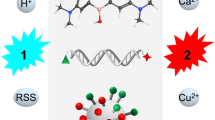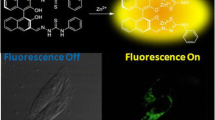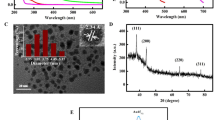Abstract
A fluorescence-enhanced sensor based on aggregation-induced emission (AIE) was synthesized using a di(2-picolyl)amine (DPA) group as a highly selective metal chelating agent for Zn2+. The combination of the probe and Zn2+ was achieved in an environment where the volume fraction of water was 90%, giving the probe good biocompatibility, and a large Stokes shift (100 nm) occurred after Zn2+ was combined with the probe. The obvious color change makes the probe visible to the naked eye, and gives it a high signal-to-noise ratio, and high contrast, and minimizes self-absorption. Because of the high selectivity of the DPA group to Zn2+, the sensitivity of the probe to detect Zn2+ has been improved. The mechanism of the formation of complexes between the probe and Zn2+ was confirmed by nuclear magnetic resonance spectroscopy (NMR), high-resolution mass spectrometry (HRMS), and particle size distribution. Under the optimal experimental conditions, the linear fluorescence reaction of Zn2+ was good, between 0.2 and 18 μM, and the detection limit was 1.3 × 10−7 M. The low toxicity and excellent membrane permeability of the probe in living cells enable it to be efficiently applied for Zn2+ imaging in cells.

Graphical abstract










Similar content being viewed by others

References
Chang C-H, Griniene R, Su Y-D, Yeh C-C, Kao H-C, Grazulevicius JV, et al. Efficient red phosphorescent OLEDs employing carbazole-based materials as the emitting host. Dyes Pigments. 2015;122:257–63.
Li P, Zhao Y, Yao L, Nie H, Zhang M. A simple, selective, fluorescent iron(III) sensing material based on peripheral carbazole. Sensors Actuators B Chem. 2014;191:332–6.
Deshapande N, Belavagi NS, Panchamukhi SI, Rabinal MH, Khazi IAM. Synthesis and optoelectronic properties of thieno[2,3-b]thiophene based bis 1,3,4-oxadiazole derivatives as blue fluorescent material for use in organic light emitting diodes. Opt Mater. 2014;37:516–9.
Li W, Wang J, Xie Y, Tebyetekerwa M, Qiu Z, Tang J, et al. Water-based fluorescent paint: presenting a novel approach to study and solve the aggregation caused quench (ACQ) effect in traditional fluorescent materials. Prog Org Coat. 2018;120:1–9.
Yan Z, Lin X, Guo H, Yang F. A novel fluorescence sensor for K+ based on bis-Bodipy: the ACQ effect controlled by cation complexation of pseudo crown ether ring. Tetrahedron Lett. 2017;58(31):3064–8.
Kagatikar S, Sunil D. Aggregation-induced emission of azines: An up-to-date review. J Mol Liq. 2019;292:111371.
He Z, Ke C, Tang BZ. Journey of aggregation-induced emission research. ACS Omega. 2018;3(3):3267–77.
Mei J, Hong Y, Lam JW, Qin A, Tang Y, Tang BZ. Aggregation-induced emission: the whole is more brilliant than the parts. Adv Mater. 2014;26(31):5429–79.
Wang Y, Zhang Y, Wang J, Liang XJ. Aggregation-induced emission (AIE) fluorophores as imaging tools to trace the biological fate of nano-based drug delivery systems. Adv Drug Deliv Rev. 2019;143:161–76.
Mao L, Liu Y, Yang S, Li Y, Zhang X, Wei Y. Recent advances and progress of fluorescent bio−/chemosensors based on aggregation-induced emission molecules. Dyes Pigments. 2019;162:611–23.
Chen X, Wang L, Yang X, Tang L, Zhou Y, Liu R, et al. A new aggregation-induced emission active fluorescent probe for sensitive detection of cyanide. Sensors Actuators B Chem. 2017;241:1043–9.
Yang B, Zhang X, Zhang X, Huang Z, Wei Y, Tao L. Fabrication of aggregation-induced emission based fluorescent nanoparticles and their biological imaging application: recent progress and perspectives. Mater Today. 2016;19(5):284–91.
Weiss JH, Sensi SL, Koh JY. Zn2+: a novel ionic mediator of neural injury in brain disease. Trends Pharmacol Sci. 2000;21(10):395–401.
Andrási E, Farkas É, Scheibler H, Réffy A, Bezúr L. Al, Zn, cu, Mn and Fe levels in brain in Alzheimer's disease. Arch Gerontol Geriatr. 1995;21(1):89–97.
Ferrada E, Arancibia V, Loeb B, Norambuena E, Olea-Azar C, Huidobro-Toro JP. Stoichiometry and conditional stability constants of cu(II) or Zn(II) clioquinol complexes; implications for Alzheimer's and Huntington's disease therapy. Neurotoxicology. 2007;28(3):445–9.
Giacconi R, Giuli C, Casoli T, Balietti M, Costarelli L, Provinciali M, et al. Acetylcholinesterase inhibitors in Alzheimer's disease influence zinc and copper homeostasis. J Trace Elem Med Biol. 2019;55:58–63.
Hassan MA, El-Nekeety AA, Abdel-Aziem SH, Hassan NS, Abdel-Wahhab MA. Zinc citrate incorporation with whey protein nanoparticles alleviate the oxidative stress complication and modulate gene expression in the liver of rats. Food Chem Toxicol. 2019;125:439–51.
Zhou F, Li C, Zhu H, Li Y. A novel method for simultaneous determination of zinc, nickel, cobalt and copper based on UV–vis spectrometry. Optik. 2019;182:58–64.
Zhu H, Wu S, Li Y, Cheng F, Wang X. A prediction method for intervals of trace ions concentration in zinc sulfate solution based on UV-vis spectroscopy. Optik. 2019;194:163065.
Feng L, Ning J, Tian X, Wang C, Zhang L, Ma X, et al. Fluorescent probes for bioactive detection and imaging of phase II metabolic enzymes. Coord Chem Rev. 2019;399:213026.
Chen H, Tang Y, Lin W. Recent progress in the fluorescent probes for the specific imaging of small molecular weight thiols in living cells. TrAC Trends Anal Chem. 2016;76:166–81.
Chen W, Liu C, Peng B, Zhao Y, Pacheco A, Xian M. New fluorescent probes for sulfane sulfurs and the application in bioimaging. Chem Sci. 2013;4(7):2892–6.
Chen W, Matsunaga T, Neill DL, Yang CT, Akaike T, Xian M. Rational Design of a Dual-Reactivity-Based Fluorescent Probe for visualizing intracellular HSNO. Angew Chem Int Ed. 2019;58(45):16067–70.
Chen W, Rosser EW, Matsunaga T, Pacheco A, Akaike T, Xian M. The development of fluorescent probes for visualizing intracellular hydrogen Polysulfides. Angew Chem Int Ed. 2015;54(47):13961–5.
Chen W, Xu S, Day JJ, Wang D, Xian M. A general strategy for development of near-infrared fluorescent probes for bioimaging. Angew Chem Int Ed. 2017;56(52):16611–5.
Lin VS, Chen W, Xian M, Chang CJ. Chemical probes for molecular imaging and detection of hydrogen sulfide and reactive sulfur species in biological systems. Chem Soc Rev. 2015;44(14):4596–618.
Chen W, Pacheco A, Takano Y, Day JJ, Hanaoka K, Xian M. A single fluorescent probe to visualize hydrogen sulfide and hydrogen Polysulfides with different fluorescence signals. Angew Chem Int Ed. 2016;55(34):9993–6.
Liu H, Tan Y, Dai Q, Liang H, Song J, Qu J, et al. A simple amide fluorescent sensor based on quinoline for selective and sensitive recognition of zinc(II) ions and bioimaging in living cells. Dyes Pigments. 2018;158:312–8.
Wang Q, Wen X, Fan Z. A Schiff base fluorescent chemsensor for the double detection of Al3+ and PPi through aggregation induced emission in environmental physiology. J Photochem Photobiol, A. 2018;358:92–9.
Zhao J, Jin G, Weng G, Li J, Zhu J, Zhao J. Recent advances in activatable fluorescence imaging probes for tumor imaging. Drug Discov Today. 2017;22(9):1367–74.
Chen Z, Zhou H, Gu W, Liu T, Xie Z, Yang L, et al. A medium-controlled fluorescent enhancement probe for ag+ and Cu2+ derived from pyrene-containing schiff base. J Photochem Photobiol, A. 2019;379:5–10.
Gao C, Jin X, Yan X, An P, Zhang Y, Liu L, et al. A small molecular fluorescent sensor for highly selectivity of zinc ion. Sensors Actuators B Chem. 2013;176:775–81.
Kim DH, Im YS, Kim H, Kim C. Solvent-dependent selective fluorescence sensing of Al3+ and Zn2+ using a single Schiff base. Inorg Chem Commun. 2014;45:15–9.
Gupta VK, Singh AK, Kumawat LK. A turn-on fluorescent chemosensor for Zn2+ ions based on antipyrine schiff base. Sensors Actuators B Chem. 2014;204:507–14.
Sarkar D, Pramanik AK, Mondal TK. Coumarin based fluorescent ‘turn-on’ chemosensor for Zn2+: An experimental and theoretical study. J Lumin. 2014;146:480–5.
Gupta VK, Mergu N, Singh AK. Fluorescent chemosensors for Zn2+ ions based on flavonol derivatives. Sensors Actuators B Chem. 2014;202:674–82.
Wen X, Wang Q, Fan Z. Highly selective turn-on fluorogenic chemosensor for Zn(II) detection based on aggregation-induced emission. J Lumin. 2018;194:366–73.
Fan J, Peng X, Wu Y, Lu E, Hou J, Zhang H, et al. A new PET fluorescent sensor for Zn2+. J Lumin. 2005;114(2):125–30.
Atilgan S, Ozdemir T, Akkaya EU. A sensitive and selective ratiometric near IR fluorescent probe for zinc ions based on the distyryl− bodipy fluorophore. Org Lett. 2008;10(18):4065–7.
Rananaware A, La DD, Bhosale SV. Solvophobic control aggregation-induced emission of tetraphenylethene-substituted naphthalene diimide via intramolecular charge transfer. RSC Adv. 2015;5(77):63130–4.
Razi SS, Ali R, Srivastava P, Misra A. A selective quinoline-derived fluorescent chemodosimeter to detect cyanide in aqueous medium. Tetrahedron Lett. 2014;55(5):1052–6.
Wen X, Wang Q, Fan Z. An active fluorescent probe based on aggregation-induced emission for intracellular bioimaging of Zn(2+) and tracking of interactions with single-stranded DNA. Anal Chim Acta. 2018;1013:79–86.
Tang K-C, Chang M-J, Lin T-Y, Pan H-A, Fang T-C, Chen K-Y, et al. Fine tuning the energetics of excited-state intramolecular proton transfer (ESIPT): white light generation in a single ESIPT system. J Am Chem Soc. 2011;133(44):17738–45.
Zhu S, Zhang J, Qiao C, Tang S, Li Y, Yuan W, et al. Strongly green-photoluminescent graphene quantum dots for bioimaging applications. Chem Commun. 2011;47(24):6858–60.
Tang Y, Huang Y, Lu L, Wang C, Sun T, Zhu J, et al. Synthesis of a new pyrene-devived fluorescent probe for the detection of Zn2+. Tetrahedron Lett. 2018;59(44):3916–22.
Tang A, Yin Y, Chen Z, Fan C, Liu G, Pu S. A multifunctional aggregation-induced emission (AIE)-active fluorescent chemosensor for detection of Zn2+ and Hg2+. Tetrahedron. 2019;75(36):130489.
Tayade K, Sahoo SK, Chopra S, Singh N, Bondhopadhyay B, Basu A, et al. A fluorescent “turn-on” sensor for the biologically active Zn2+ ion. Inorg Chim Acta. 2014;421:538–43.
Dutta K, Deka RC, Das DK. A new fluorescent and electrochemical Zn2+ ion sensor based on Schiff base derived from benzil and L-tryptophan. Spectrochim Acta, Part A. 2014;124:124–9.
Author information
Authors and Affiliations
Corresponding author
Ethics declarations
Conflict of interest
The authors declare that they have no conflict of interest.
Statement concerning human and animal rights
In this study, only urine samples from laboratory personnel were used, and each participant signed informed consent. The samples were used solely for this study. No markers were used that contained personally identifying information of donors. Animals were not involved in this study.
Additional information
Publisher’s note
Springer Nature remains neutral with regard to jurisdictional claims in published maps and institutional affiliations.
Electronic supplementary material
ESM 1
(PDF 701 kb)
Rights and permissions
About this article
Cite this article
Yan, L., Wen, X. & Fan, Z. A large-Stokes-shift fluorescent probe for Zn2+ based on AIE, and application in live cell imaging. Anal Bioanal Chem 412, 1453–1463 (2020). https://doi.org/10.1007/s00216-019-02378-w
Received:
Revised:
Accepted:
Published:
Issue Date:
DOI: https://doi.org/10.1007/s00216-019-02378-w



